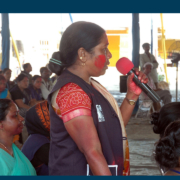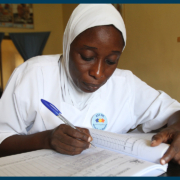Using the Community Action Cycle to Build Trust in Guinea
In many communities, Guineans demonstrate a lingering reluctance to visit health care facilities, choosing instead to consult traditional medicine and other healers. In addition to contending with mistrust from local communities, health centers are often understaffed and are unclear about their roles and responsibilities. As a result, the demand for health services remains low despite prevalent health conditions and preventable deaths in these communities.
The Western African Ebola virus epidemic of 2014–16, during which 11,323 people lost their lives to the disease, further exacerbated the communities’ mistrust of health professionals and health facilities. In response, Breakthrough ACTION teamed up with six local nongovernmental organizations (NGOs) to work directly with 47 local communities, health centers, and their established networks of health professionals using the Community Action Cycle (CAC). The CAC is an innovative social and behavior change (SBC) approach to community engagement that helps community members work together to identify health problems. Then, they work together to propose appropriate solutions for improving services within the health care facilities. A sequence of interventions (Figure 1), enables the community to use existing health data to plan, implement, and monitor local solutions.

Figure 1: Phases of the Community Action Cycle
In the sub-prefecture of Koba in Guinea, Breakthrough ACTION worked with the Initiative et Action pour l’Amélioration de la Santé des Populations (Initiative and Action for Improving the Health of Populations [INAASPO]) NGO to implement SBC activities using the CAC. This partnership aimed to address priority health issues related to malaria, family planning and reproductive health, nutrition, and maternal, newborn, and child health, as well as to encourage community members to take charge of their health problems and cultivate trust with health care workers.

Community members and health professionals unite for an orientation with community mobilization teams.
The participatory nature of CAC ensured that the voices and needs of every relevant community actor, including health personnel, administrative authorities, and local community leaders, were heard and respected. Breakthrough ACTION and INAASPO held community meetings with community members and health care providers, during which participants identified and prioritized problems in the community and developed an action plan based on locally-sourced solutions that the community then implemented themselves.
One such problem identified during community meetings was that pregnant women do not go to health facilities due to the low quality of care and poor treatment they received from health workers. To improve the quality of services, Breakthrough ACTION:
- Strengthened the capacity of NGO staff according to performance criteria.
- Strengthened the capacity of Community Mobilization Teams (CMTs), which are central to the CAC process, by training master trainers who then trained others.
- Planned, implemented, and monitored community-based activities with CMTs to generate demand for prenatal care services.

Women at Health Center of Boffa for a sensitization event.
Because the women of Koba were involved in the CAC process, they came to understand the importance of antenatal care (ANC) for their health, their children’s health, and the overall well-being of their community. As a result, the community reported that both the quality of services and treatment of pregnant women improved in the health centers.
Breakthrough ACTION’s CAC-based initiative sparked enthusiasm among health center patients and generated an increase in pregnant women accessing care. The head of the health center confirmed that only 25% of pregnant women in the local community went to health centers to receive ANC before implementing the CAC process. In the three months following the community meetings, 75% of pregnant women in the community attended ANC at health centers. These encouraging results reflect an increased trust among pregnant women in their local health centers and would not have been possible without the CAC process led by Breakthrough ACTION and local partners.
Before the Breakthrough ACTION project arrived, the health center only received 15 to 20 women per month, but now it receives more than 50 to 80 women per month.
– Ismael Traoré, Head of the Koba Health CenterInvolving communities in the identification of their priority problems helps to take into account the real needs of the community.
– Ousmane Camara, President of COSAH of Koba


 Sara Holbak/VectorWorks/Photoshare
Sara Holbak/VectorWorks/Photoshare
 Gopal Bhattacharjee/Photoshare
Gopal Bhattacharjee/Photoshare
 © 2012 CCP/NURHI 2, Courtesy of Photoshare
© 2012 CCP/NURHI 2, Courtesy of Photoshare 2019 CORE Group Global Health Practitioner Conference
2019 CORE Group Global Health Practitioner Conference